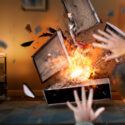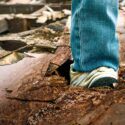It’s a quite start to the day, as the morning sun illuminates the urban paradise below your apartment. The silence shatters when an explosion tears through the streets from a nearby building.
With the debris rapidly heading your way, here’s what you need to know on How to Survive a Building Explosion. Devastating but rare, the long-term effects created by building explosions are disastrous enough to last a lifetime.
In 2020, Samah Hadid compared the building explosion she survived to an earthquake. The sudden blast shattered her windows, spreading glass across the floor.
As the ceiling rained down on Samah and her infant child, she felt at any moment her home would collapse beneath her. This family came out of the rubble alive, but what if you’re in a high-rise building?
How do you handle a shockwave? How can you be injured?
No matter how they occur, building explosions create chaos in the moment. But it’s the physical and mental trauma that haunts the survivors like a recurring nightmare. Should you find yourself in the midst of this frenzy, follow these steps.
Step 1: Stay Away From the Blast Site
While you cannot help your proximity to the blast site during the explosion, afterwards keep your distance and if possible leave the area immediately. If the explosion creates a fireball, the temperature can rise up to 4,000 degrees Celsius (7,200 degrees Fahrenheit) at the source, scorching the human body in an instant and possibly setting off subsequent explosions.
At the detonation site, the air pressure expands outward rapidly, creating a vacuum. Known as a blast wind, this tiny void refills itself by exerting a massive force that pulls in every nearby object and person.
Stay clear of the epicenter to avoid these high velocity winds. If you’re in the building where the blast occurred, don’t use the elevators, and look for emergency officials at the scene. And if you’re in a building that’s safe and away from the site, stay there. Avoid your human instinct to rush into danger or you could end up as another victim.
Step 2: Stay Near the Ground
The explosion sends out a blast wave made of highly compressed air particles moving faster than the speed of sound. On impact, this initial wave causes the most damage to structures and the your body. Suck in that gut, because your gastrointestinal tract is completely vulnerable during this blast, putting your vital organs at risk of internal rupturing and tearing.
Keeping low can also keep you safer from the debris flying above your head and the blast wave itself. After this, if you feel nausea and abdominal pain, seek immediate medical attention.
Step 3: Empty Your Lungs
When in crisis, humans naturally desire to hold their breath. But if your lungs are filled with too much air, they could burst as a shockwave rips through your body.
A shockwave is a supersonic concussive force following the blast wave. This deadly wave expands outward and up, carrying energy as it passes through objects and organs like your lungs. Breathing in small intervals will keep the pressure in your lungs low, making them less likely to burst.
Step 4: Stay Away From Windows
Your eyes are sensitive enough to be damaged by the blast wave, even without direct contact, causing lesions and impairing your vision for life. Keep your head down though, the real danger is yet to come.
While the blast wave will shatter windows near the site, it’s the lethal shockwave that breaks windows further away. Stay away from windows to avoid the the flying glass which could cause significant damage to your eyes. Eye injuries are potentially fatal and are suffered by one out of every ten blast survivors. While you might think you’re safe at a distance, that bird’s eye view could be the last thing you see.
Step 5: Protect Your Head
Your ears are also dangerously at risk, depending on your orientation to the blast. With the pressure rising to over 103 kilopascals, or 15 pounds per square inch, in an instant, the blast wave is strong enough to rupture your eardrums, possibly causing permanent hearing loss.
Cover your head with your arms and curl into a ball, tucking your face close to your chest. Even without a direct hit to the head, the primary blast can be strong enough to cause a concussion or a mild brain injury.
While the blast wave ends in milliseconds, the trauma of this event can follow you the rest of your life. In addition to the lingering physical damage done to their bodies, survivors of building explosions often suffer from post-traumatic stress disorder (PTSD) and the guilt of being alive.
Long after the rubble has been cleared and the dead are laid to rest, people can feel a sense of shame for surviving when many didn’t. Consider seeking medical advice when dealing with PTSD or bodily trauma to prevent any of these negative long-term effects.
Sources
- “Enormous Explosion Rocks Beirut, Killing More Than 100, Wounding Thousands”. 2020. npr.org.
- “Lebanese Journalist Describes Office Shattering Around Him In Beirut Explosion | CBC Radio”. 2020. CBC.
- “How Blast-Resistant Clothing Works”. Howstuffworks.
- “Explosions and Blast Injuries” 2020. cdc.gov.
- “Survivors Of Beirut Explosion On Where They Were And The Horrifying Aftermath”. ABC News.
- “Texas City Disaster Survivor Shares Story Of Explosion”. 2020. ABC13 Houston.
- “ISC Security Design Criteria For New Federal Office Buildings And Major Modernization Projects”. 2003. doi:10.17226/10678.



























